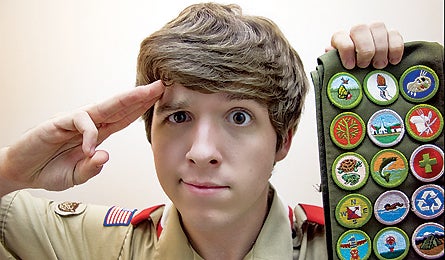The Boy Scout Quiz

'(Photo by Hunter Wilson)'
1. The “Hypothermia Challenge” is:
a. A cold-water immersion test held at the annual National Scout Jamboree. Winners earn the Polar Bear Merit Badge.
b. A winter version of the Pinewood Derby in which contestants race homemade cars on frozen lakes
c. A test to determine if hypothermia is a risk: Can you walk heel-to-toe on a 30-foot line scratched into the ground?
2. True or False? In a thunderstorm, taking shelter in a steel-framed building is your safest choice.
3. Which one of the following is not a sign of dehydration?
a. headache
b. confusion
c. profuse sweating
d. fatigue
4. Avalanches occur most frequently on slopes that are between ___ and ____ degrees.
5. Which one of the following is not a designated role on a Scout backpacking trip? a. navigator
b. sweep
c. chef
d. pacesetter
6. Heatstroke occurs when a person’s core temperature rises higher than:
a. 98°F
b. 101°F
c. 105°F
d. 108°F
7. Which snake color pattern is dangerous?
a. Red on yellow
b. Red on black
8. In cold weather, grayish-white patches of skin indicate frostbite has already set in. Or is it frostnip?
9. On a topographic map, the color purple:
a. Designates manmade structures–buildings, bridges, railroads, etc.
b. Shows revisions that are based on aerial photos.
c. Indicates areas with high concentrations of seasonal wildflowers.
10. Scouting began in which country:
a. Canada
b. South Africa
c. United States
d. England
11. You’re lost in the backcountry. You should…
a. Use thumbnail navigation. It will get you back to your last known location.
b. Hike south. Anywhere in the Lower 48, you’re sure to cross a road within 10 miles.
c. Stay put, make your team comfortable, and wait for rescue.
12. True or false? Mild electric shock (such as from a car battery) is an effective method of treating a snakebite.
13. Leave No Trace guidelines say your dishwashing site should be how many feet from streams, lakes, or rivers? a. 100
b. 200
c. 200, downwind
d. 300 from camp
14. The difference between a true north line and the direction that a magnetic compass needle points is called ____?
15. The first thing to fail on a tent is usually the:
a. zipper
b. pole
c. stake
d. floor
16. “Smellable items,” or things with an odor that could entice a bear to enter your tent, include everything except: a. dried salmon
b. gorp
c. sunscreen
d. dirty socks
e. Wet Wipes
17. When planning a route, expect to travel no faster than:
a. 10 miles per day
b. The slowest hiker in your group
c. 2 miles per hour
d. Your scoutmaster
18. In order to earn a Backpacking merit badge, which of the following is not required?
a. Demonstrate two ways to treat water and explain why this is essential
b. Describe a good campsite
c. Do a solo overnight at Philmont Scout Ranch in New Mexico
d. Plan and go on a five-day, 30-mile backpacking trip
19. Consult a doctor if a tick has been embedded in your skin longer than: a. one minute
b. 12 hours
c. 24 hours
d. 3 days
20. True or False? A hybrid tent is one that was made by two different designers.
21. The best way to assure your drinking water is safe is to:
a. boil it
b. sip only the water
you brought from home
c. filter it
d. add iodine
22. True or False? If you apply ice to a snakebite, it will hurt less and heal faster.
23. For any trek, your pack should weigh no more than ____ percent of your body weight.
24. Which is warmer on a winter backpacking trip: a tent or a snowcave?
25. True or false? New studies show that bear spray, if applied to your clothes and backpack two hours before hiking, is the most effective way to ward off grizzlies.
26. A person suffering from heat exhaustion can take ____ (12-24 or 24-48) hours to recover.
27. Which of the following is not part of the Boy Scout Oath:
a. to help other people at all times
b. to be physically strong
c. to be morally straight
d. to be clean shaven always
e. to be mentally awake
How’d you do? Check the answers and scoring key.